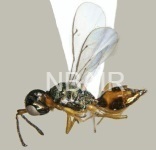Scientific name
Panstenon Walker, 1846
Taxonomic position
Hymenoptera: Chalcidoidea: Pteromalidae
Diagnosis
Head wider than mesosoma; face convex and shiny; antennal formula 11263; antennal inserted high on face, clearly above ventral margin of eyes; clypeus almost as high as wide; wings very slender, fore wing long and narrow, costal cell very narrow, about 3 times as long as wide, marginal vein at least 3 times as long as stigmal vein, entirely setose. Pronotum elongate, subconical, in lateral view as long as high; mesosoma convex; notauli mostly incomplete; propodeum with coarse rugae. Petiole widening posteriorly; metasoma often partly yellow.
Image
 Adult - lateral view Adult - lateral view
Biology / Hosts
Associated with grasses and their hosts seem to be insect eggs (mainly hemipterous eggs) and larvae developing in the internode of the grass stems (Boucek, 1988). Species are mainly reported as egg parasitoids and sometimes as egg predators (Xiao & Huang, 2000).
Distribution
West Bengal and Kerala.
References
- Boucek, Z. 1988. Australasian Chalcidoidea (Hymenoptera). C. A. B. International, Wallingford, U.K. pp. 832.
- Narendran, T.C. and Girish Kumar, P. 2009. Three new species of Pteromalidae (Hymenoptera: Chalcidoidea) from Sunderbans, West Bengal, India. Journal of Environment & Sociobiology 6(2):124-126.
- Xiao, H. and Huang, D.W. 2000. A taxonomic study of Panstenon (Hymenoptera: Pteromalidae: Panstenoninae) from China. Oriental Insects 34:302, 303-304.
|